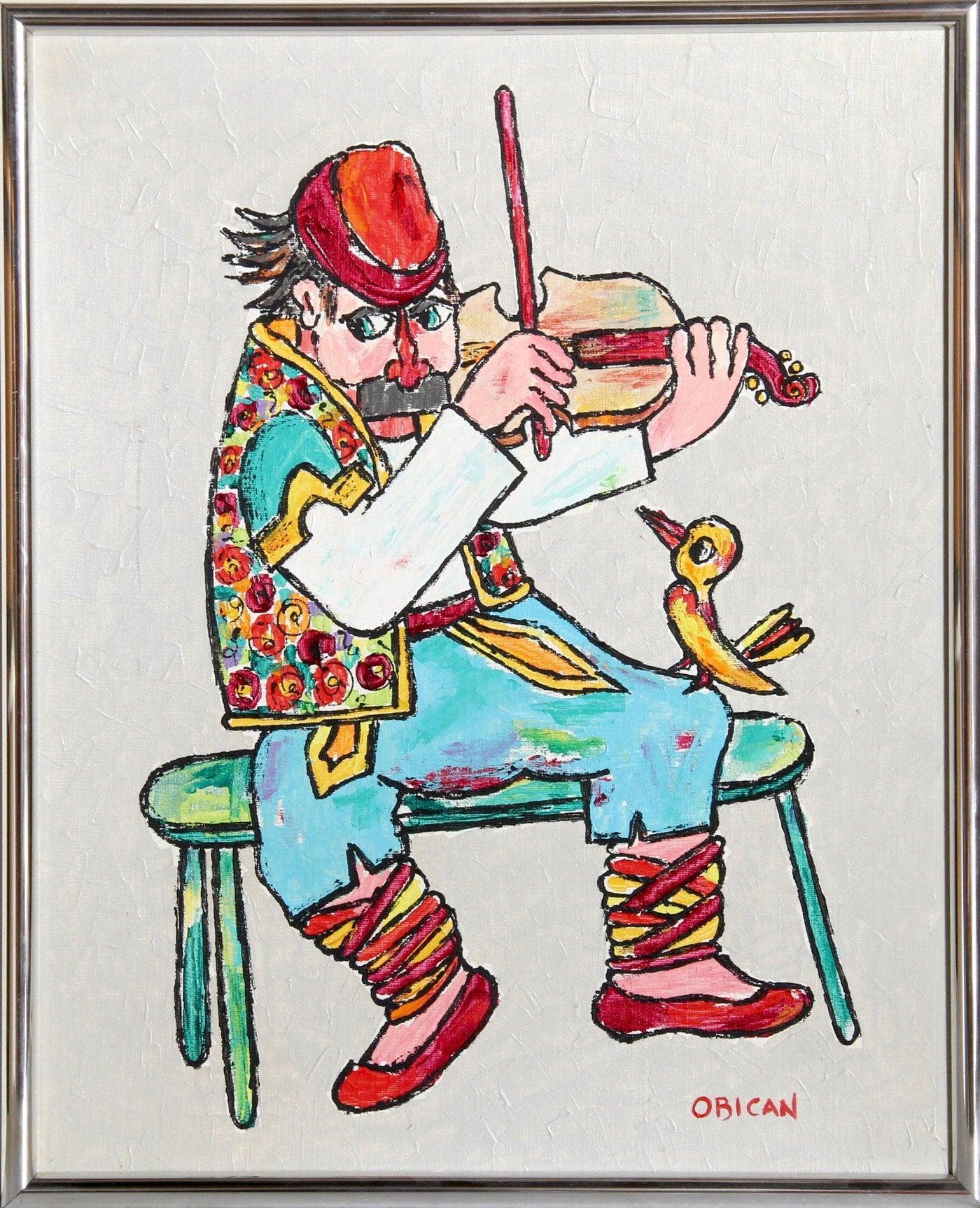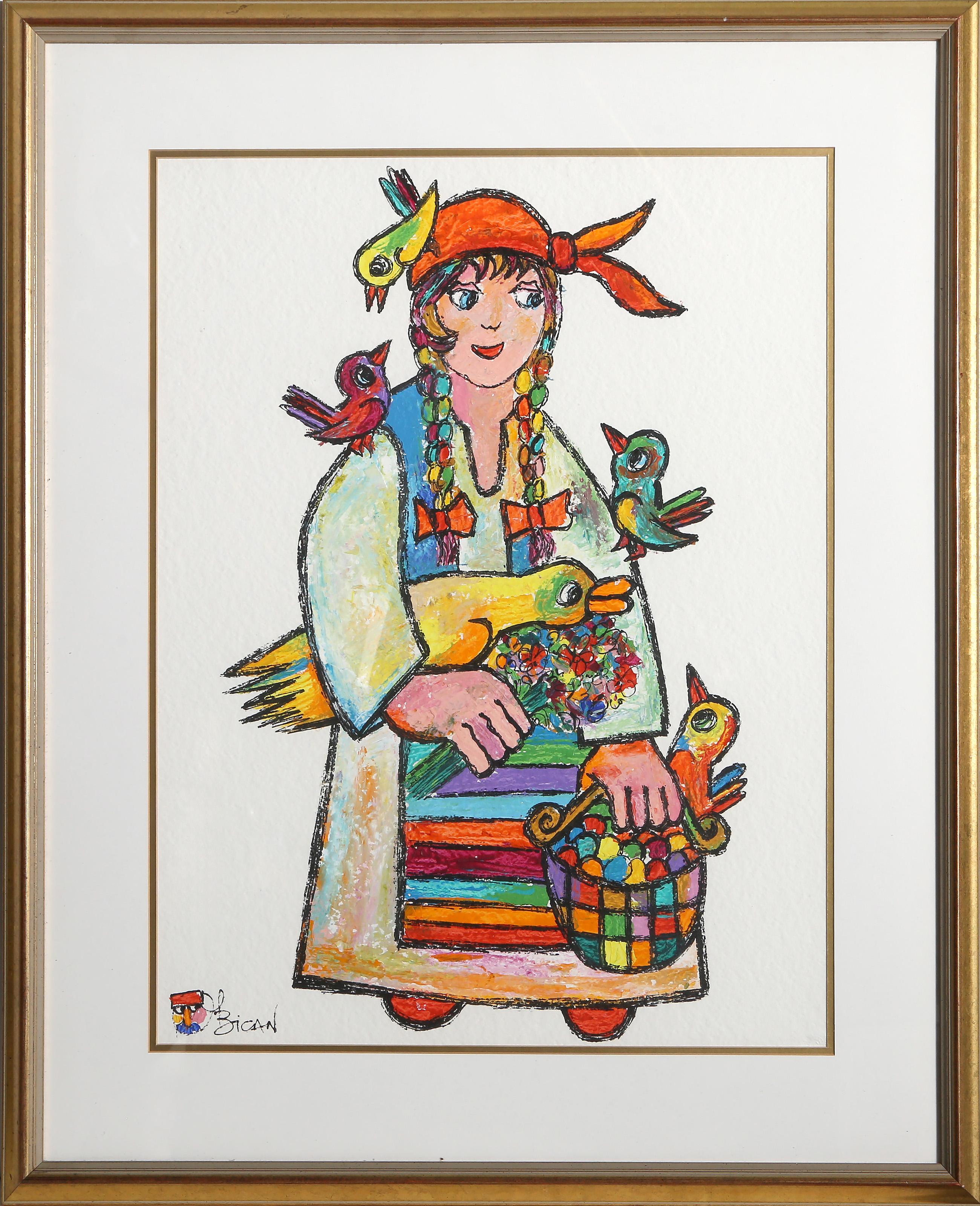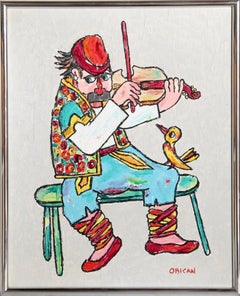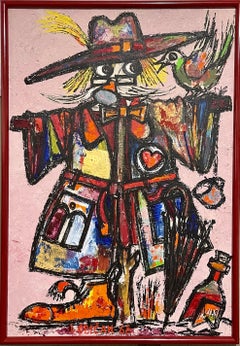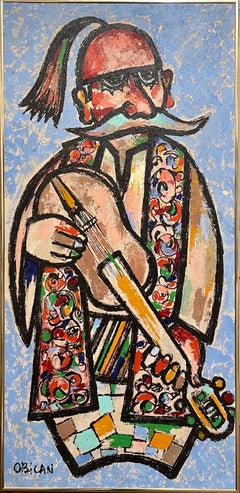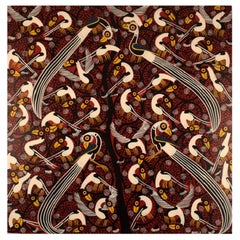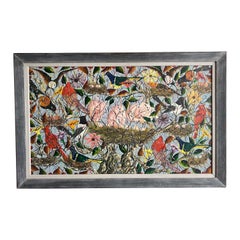Items Similar to Traveler with Birds, Signed Oil on Board by Jovan Obican
Want more images or videos?
Request additional images or videos from the seller
1 of 6
Jovan ObicanTraveler with Birds, Signed Oil on Board by Jovan Obicancirca 1980
circa 1980
$2,500
£1,898.95
€2,188.24
CA$3,520.62
A$3,903.13
CHF 2,051.25
MX$47,767.87
NOK 25,617.97
SEK 24,045.03
DKK 16,333.85
About the Item
Traveler with Birds
Jovan Obican
French/Yugoslavian (1918–1986)
Date: circa 1980
Oil on board, signed
Size: 29.5 x 23.5 in. (74.93 x 59.69 cm)
Frame Size: 31 x 25 inches
- Creator:Jovan Obican (1918-1986, French)
- Creation Year:circa 1980
- Dimensions:Height: 31 in (78.74 cm)Width: 25 in (63.5 cm)
- Medium:
- Movement & Style:
- Period:
- Condition:
- Gallery Location:Long Island City, NY
- Reference Number:Seller: RO557741stDibs: LU46615802072
About the Seller
4.9
Platinum Seller
Premium sellers with a 4.7+ rating and 24-hour response times
Established in 1979
1stDibs seller since 2014
3,096 sales on 1stDibs
Typical response time: 1 hour
- ShippingRetrieving quote...Shipping from: Long Island City, NY
- Return Policy
Authenticity Guarantee
In the unlikely event there’s an issue with an item’s authenticity, contact us within 1 year for a full refund. DetailsMoney-Back Guarantee
If your item is not as described, is damaged in transit, or does not arrive, contact us within 7 days for a full refund. Details24-Hour Cancellation
You have a 24-hour grace period in which to reconsider your purchase, with no questions asked.Vetted Professional Sellers
Our world-class sellers must adhere to strict standards for service and quality, maintaining the integrity of our listings.Price-Match Guarantee
If you find that a seller listed the same item for a lower price elsewhere, we’ll match it.Trusted Global Delivery
Our best-in-class carrier network provides specialized shipping options worldwide, including custom delivery.More From This Seller
View AllMan with Yellow Bird, Signed Oil on Board by Jovan Obican
By Jovan Obican
Located in Long Island City, NY
Man with Yellow Bird
Jovan Obican
French/Yugoslavian (1918–1986)
Oil on Board, signed l.l.
Size: 29.5 x 23.5 in. (74.93 x 59.69 cm)
Frame Size: 32 x 25.5 inches
Category
1980s Folk Art Paintings
Materials
Oil
Man with Flower and Birds, Oil on Board Folk Art Painting by Jovan Obican
By Jovan Obican
Located in Long Island City, NY
Man with Flower and Birds
Jovan Obican
French/Yugoslavian (1918–1986)
Date: circa 1980
Oil on board
Size: 9 x 7 in. (22.86 x 17.78 cm)
Frame Size: 9.75 x 7.25 inches
Category
1980s Folk Art Paintings
Materials
Oil
Man with Flower and Bird, Signed Oil on Board by Jovan Obican
By Jovan Obican
Located in Long Island City, NY
Man with Flower and Bird
Jovan Obican
French/Yugoslavian (1918–1986)
Date: circa 1980
Oil on board
Size: 28 x 22 in. (71.12 x 55.88 cm)
Frame Size: 30 x 24 inches
Category
1980s Folk Art Paintings
Materials
Oil
Fiddler, Signed Folk Art Oil on Board by Jovan Obican
By Jovan Obican
Located in Long Island City, NY
Fiddler
Jovan Obican
French/Yugoslavian (1918–1986)
Date: circa 1980
Oil on board
Size: 16 x 20 in. (40.64 x 50.8 cm)
Frame Size: 21 x 17 inches
Category
1980s Folk Art Paintings
Materials
Oil
Woman with Birds, Folk Art Acrylic Painting on paper by Jovan Obican
By Jovan Obican
Located in Long Island City, NY
Jovan Obican, French/Yugoslavian (1918 - 1986) - Woman with Birds, Medium: Acrylic on paper, signed lower left, Size: 27 x 21 in. (68.58 x 53.34 cm), Frame Size: 36.5 x 30.5 inches
Category
Mid-20th Century Folk Art Figurative Paintings
Materials
Acrylic
Scarecrow, 1983 Signed Oil Painting by Jovan Obican
By Jovan Obican
Located in Long Island City, NY
Scarecrow
Jovan Obican
French/Yugoslavian (1918–1986)
Date: 1983
Oil on Canvas, signed l.l.
Size: 40 x 30 in. (101.6 x 76.2 cm)
Frame Size: 43 x 32.5 inches
Category
1980s Folk Art Paintings
Materials
Oil
You May Also Like
Large Naive European Folk Art Oil Painting Lazar Obican French Scarecrow Clown
Located in Surfside, FL
Lazar Obican 1944-2004
Genre: Other
Subject: People
Medium: Oil
Surface: Canvas
Dimensions: 35" x 16.5
Dimensions w/Frame: 35.5" x 17.25
An impasto composition that depicts a colorful scarecrow clown with a bird perched on his shoulder with a bottle of French Vin (wine)
Artist signature L OBICAN to bottom and dated 1968. Title to verso.
Work Size: 36 x 25 in. Framed 37.5 x 26 x 1 in
The artist Lazar Obican iconic style is child-like yet masterfully adult; a style that tells a story with sociological overtones. His funny little people are always colorful, full of spirit, living with music and birds to bring them happiness.
Lazar Obican artist, painter, sculpture and mosaic ceramic artisan was born in Cannes, France, to his Yugoslavian family. He finished his training, imbued with the spirit of his native country, the people, their legends, and their philosophy. It has been said that his work has a "timeless quality" and a naive, folk art, outsider art brut quality, child-like primitive style. Obican is identified with his style the world over, a style that is simple yet sophisticated; child-like yet masterfully adult; a style that tells a story with psychological, philosophical or sociological overtones. His funny little people are always colorful, full of spirit, living with music and birds to bring them happiness. Best known for his depictions of folklore and traditional costumes rendered in a playful, childlike style and for his happy Jewish wedding scenes. He often used bright colors and black outlines in his renderings of figures and animals, giving his work an illustration-like quality. Thematically, the artist’s work is similar to Marc Chagall and Jean Dubuffet for its dreamlike images and so-called naïve style of painting. Over the course of his career, the artist maintained a studio in Boca Raton, Florida and Dubrovnik, Croatia—part of former Yugoslavia— where he developed an interest in Eastern Europe’s Jewish culture. Many of his mature works depict Jewish traditions and ceremonies, including traditional Jewish weddings, the dancing of the Hora, and traditional music. There is a display of his works in his former Dubrovnik studio.
His style is a unique conglomerate of tradition, history, legends, heroes, old customs and folklore. It is a self-standing style, recognizable, cheerful, whimsical and a happy creation. Naïve art is any form of visual art that is created by a person who lacks the formal education and training that a professional artist undergoes (in anatomy, art history, technique, perspective, ways of seeing). Unlike folk art, naïve art does not necessarily evince a distinct cultural context or tradition. Naïve art is recognized, and often imitated, for its childlike simplicity and frankness. Paintings of this kind typically have a flat rendering style with a rudimentary expression of perspective.
One particularly influential painter of "naïve art" was Henri Rousseau (1844–1910), a French Post-Impressionist who was discovered by Pablo Picasso. Naïve art is often seen as outsider art that is by someone without formal (or little) training or degree. While this was true before the twentieth century, there are now academies for naïve art. Naïve art is now a fully recognized art genre, represented in art galleries worldwide.
Museums devoted to naïve art now exist in Kecskemét, Hungary; Riga, Latvia; Jaen, Spain; Rio de Janeiro, Brasil; Vicq France and Paris. "Primitive art" is another term often applied to art by those without formal training, but is historically more often applied to work from certain cultures that have been judged socially or technologically "primitive" by Western academia, such as Native American, sub saharan African or Pacific Island art (see Tribal art). This is distinguished from the self-conscious, "primitive" inspired movement primitivism. Another term related to (but not completely synonymous with) naïve art is folk art. There also exist the terms "naïvism" and "primitivism" which are usually applied to professional painters working in the style of naïve art (like Paul Gauguin, Mikhail Larionov, Paul Klee).
At all events, naive art can be regarded as having occupied an "official" position in the annals of twentieth-century art since - at the very latest - the publication of the Der Blaue Reiter, an almanac in 1912. Wassily Kandinsky and Franz Marc, who brought out the almanac, presented 6 reproductions of paintings by le Douanier' Rousseau (Henri Rousseau), comparing them with other pictorial examples. However, most experts agree that the year that naive art was "discovered" was 1885, when the painter Paul Signac became aware of the talents of Henri Rousseau and set about organizing exhibitions of his work in a number of prestigious galleries. The Earth Group (Grupa Zemlja) were Croatian artists, architects and intellectuals active in Zagreb from 1929 to 1935. The group included the painters Krsto Hegedušić, Edo Kovačević, Omer Mujadžić, Kamilo Ružička, Ivan Tabaković, and Oton Postružnik, the sculptors Antun Augustinčić, Frano Kršinić, and the architect Drago Ibler. A term applied to Yugoslav (Croatian) naive painters working in or around the village of Hlebine, near the Hungarian border, from about 1930. Some of the best known naive artists are Dragan Gaži, Ivan Generalić, Josip Generalić, Krsto Hegedušić, Mijo Kovačić, Ivan Lacković-Croata, Franjo Mraz, Ivan Večenaj and Mirko Virius. Camille Bombois (1883–1970) Ferdinand Cheval, known as 'le facteur Cheval' (1836–1924) Henry Darger (1892–1973) L. S. Lowry (1887–1976) Grandma Moses, Anna Mary Robertson...
Category
1960s Folk Art Figurative Paintings
Materials
Canvas, Oil
Large Naive European Folk Art Oil Painting Jovan Obican Klezmer Jazz Musician
By Jovan Obican
Located in Surfside, FL
Genre: Other
Subject: People
Medium: Oil
Surface: Canvas
Dimensions: 35" x 16.5
Dimensions w/Frame: 35.5" x 17.25
This depicts a Jazz or Klezmer musician. This one is a banjo or guitar player.
The last photo shows it in a group of three that I have available. This listing is for the one painting.
The artist Jovan Obican iconic style is child-like yet masterfully adult; a style that tells a story with sociological overtones. His funny little people are always colorful, full of spirit, living with music and birds to bring them happiness.
JOVAN OBICAN
Cannes, France, b. 1918, d. 1986
Jovan Obican (1918-1986) artist, painter, sculpture and mosaic ceramic artisan was born in Cannes, France, to his Yugoslavian parents. From childhood on, Jovan practically devoted himself to art, scratching designs into the dirt when paper was unavailable. He trained with many recognized teachers and with many styles. He finished his training, imbued with the spirit of his native country, the people, their legends, and their philosophy. It has been said that his work has a "timeless quality" and a naive, folk art, outsider art brut quality, child-like primitive style. Obican is identified with his style the world over, a style that is simple yet sophisticated; child-like yet masterfully adult; a style that tells a story with psychological, philosophical or sociological overtones. His funny little people are always colorful, full of spirit, living with music and birds to bring them happiness. Best known for his depictions of folklore and traditional costumes rendered in a playful, childlike style and for his happy Jewish wedding scenes. He often used bright colors and black outlines in his renderings of figures and animals, giving his work an illustration-like quality. Thematically, the artist’s work is similar to Marc Chagall and Jean Dubuffet for its dreamlike images and so-called naïve style of painting. Over the course of his career, the artist maintained a studio in Boca Raton, Florida and Dubrovnik, Croatia—part of former Yugoslavia— where he developed an interest in Eastern Europe’s Jewish culture. Many of his mature works depict Jewish traditions and ceremonies, including traditional Jewish weddings, the dancing of the Hora, and traditional music. There is a display of his works in his former Dubrovnik studio.
His style is a unique conglomerate of tradition, history, legends, heroes, old customs and folklore. It is a self-standing style, recognizable, cheerful, whimsical and a happy creation. Naïve art is any form of visual art that is created by a person who lacks the formal education and training that a professional artist undergoes (in anatomy, art history, technique, perspective, ways of seeing). Unlike folk art, naïve art does not necessarily evince a distinct cultural context or tradition. Naïve art is recognized, and often imitated, for its childlike simplicity and frankness. Paintings of this kind typically have a flat rendering style with a rudimentary expression of perspective.
One particularly influential painter of "naïve art" was Henri Rousseau (1844–1910), a French Post-Impressionist who was discovered by Pablo Picasso. Naïve art is often seen as outsider art that is by someone without formal (or little) training or degree. While this was true before the twentieth century, there are now academies for naïve art. Naïve art is now a fully recognized art genre, represented in art galleries worldwide.
Museums devoted to naïve art now exist in Kecskemét, Hungary; Riga, Latvia; Jaen, Spain; Rio de Janeiro, Brasil; Vicq France and Paris. "Primitive art" is another term often applied to art by those without formal training, but is historically more often applied to work from certain cultures that have been judged socially or technologically "primitive" by Western academia, such as Native American, sub saharan African or Pacific Island art (see Tribal art). This is distinguished from the self-conscious, "primitive" inspired movement primitivism. Another term related to (but not completely synonymous with) naïve art is folk art. There also exist the terms "naïvism" and "primitivism" which are usually applied to professional painters working in the style of naïve art (like Paul Gauguin, Mikhail Larionov, Paul Klee).
At all events, naive art can be regarded as having occupied an "official" position in the annals of twentieth-century art since - at the very latest - the publication of the Der Blaue Reiter, an almanac in 1912. Wassily Kandinsky and Franz Marc, who brought out the almanac, presented 6 reproductions of paintings by le Douanier' Rousseau (Henri Rousseau), comparing them with other pictorial examples. However, most experts agree that the year that naive art was "discovered" was 1885, when the painter Paul Signac became aware of the talents of Henri Rousseau and set about organizing exhibitions of his work in a number of prestigious galleries. The Earth Group (Grupa Zemlja) were Croatian artists, architects and intellectuals active in Zagreb from 1929 to 1935. The group included the painters Krsto Hegedušić, Edo Kovačević, Omer Mujadžić, Kamilo Ružička, Ivan Tabaković, and Oton Postružnik, the sculptors Antun Augustinčić, Frano Kršinić, and the architect Drago Ibler. A term applied to Yugoslav (Croatian) naive painters working in or around the village of Hlebine, near the Hungarian border, from about 1930. Some of the best known naive artists are Dragan Gaži, Ivan Generalić, Josip Generalić, Krsto Hegedušić, Mijo Kovačić, Ivan Lacković-Croata, Franjo Mraz, Ivan Večenaj and Mirko Virius. Camille Bombois (1883–1970) Ferdinand Cheval, known as 'le facteur Cheval' (1836–1924) Henry Darger (1892–1973) L. S. Lowry (1887–1976) Grandma Moses, Anna Mary Robertson...
Category
20th Century Folk Art Figurative Paintings
Materials
Canvas, Oil
Hapela, Tinga Tinga, Oil on Canvas, Naivist Composition with Birds
Located in København, Copenhagen
Hapela. Tinga Tinga. Oil on canvas. Naivist composition with giraffes and birds.
Late 20th century.
The canvas measures: 79 x 79 cm.
The frame measures...
Category
Late 20th Century Unknown Paintings
Materials
Canvas
Large Birds and Flowers Haitian Modern Oil Painting on Board
Located in Miami, FL
Spectacular oil on board of multiple birds and lots of flowers. A large format painting. In the modern naive Haitian style.
Category
Vintage 1970s Haitian Paintings
Materials
Paint
“Boy with Blue Birds”
By Agapito Labios
Located in Southampton, NY
Original oil on canvas folk art painting by the well known Mexican artist, Agapito Labios. Signed lower right. Circa 1935. Condition is very good. ...
Category
1930s Folk Art Figurative Paintings
Materials
Canvas, Oil
Organ Grinder with Parrot Modern Judaica Oil Painting WPA Jewish artist
By Maurice Kish
Located in Surfside, FL
Genre: Modern
Subject: Organ grinder with parrot
Medium: Oil
Surface: Board, size includes artist decorated frame
Country: United States
The imagery of Maurice Kish (1895-1987), wh...
Category
Mid-20th Century Modern Figurative Paintings
Materials
Oil
More Ways To Browse
Oil 1918
Vintage Van Painting
Belgian School
Modern Horse Art
Impressionist Painting In Garden
Impressionist Painting Mountains
Impressionist Painting Pink
Oil Painting Couple
Mountain House Art
Original Water Colour Paintings
Spirit House
School Girl
American Impressionism Painting
5x7 Frame
21st Century Impressionism
J Brown Painting
Soviet Art
Still Life Oil Paintings On Board
